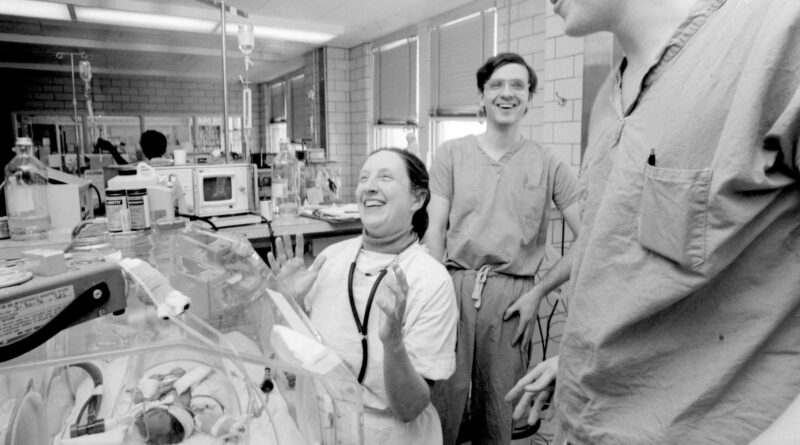A Legacy Lived
Published on November 11th, 2022 by Bill Snyder.
On July 31, Mildred Stahlman, MD, known internationally for advancing the treatment and care of premature babies, reached another milestone — her 100th birthday.
Professor of Pediatrics at Vanderbilt University Medical Center, Stahlman does not like to be called a pioneer in her field of neonatology. “Many people did much more than I did,” she said in 2005. “My idea of science is that everything is built on the backs of somebody else.”
Yet among her many achievements, Stahlman is credited with establishing, in 1961, the nation’s first newborn intensive care unit to use monitored ventilation therapy on infants with damaged lungs.
She worked tirelessly to regionalize medical care services for newborns and high-risk mothers. To get sick babies safely to the hospital, in the early 1970s she helped develop a neonatal transport system called “Angel” that has been copied nationwide and which continues today.
“For my 30 years here, she has been an example of what the single-minded determination of an extraordinary woman can do to make things better for babies and their mothers,” said William Walsh, MD, professor of Pediatrics and past Chief of Nurseries at Monroe Carell Jr. Children’s Hospital at Vanderbilt. “I am honored to know her.”
At the start of her career, Stahlman was among few women faculty members in the Vanderbilt University School of Medicine (VUSM). She insisted on the highest standard of excellence, both for herself and for the many resident physicians and research fellows she trained.
“She was terrifying,” recalled Meg Rush, MD, MMHC, President of Monroe Carell and professor of Clinical Pediatrics, who first encountered Stahlman as an intern in Pediatrics in 1984, “… but it was with an eye to make you a better physician and to challenge you intellectually, building critical thinking skills.”
Now retired to her log house in Brentwood, Tennessee, and in frail health, Stahlman’s essential quality — her love of people — is undimmed. “In my eyes, she remains one of the most significant role models and inspirations in my life,” said longtime friend and colleague Odessa Settles, RN, MSN, CM.
“Millie” Stahlman and her sister Ann, who died in 2014, grew up in the 1920s and ‘30s in Nashville’s then-rural southern outskirts. Their father, James G. Stahlman, was publisher of the afternoon newspaper, the Nashville Banner, and a longtime member of the Vanderbilt University Board of Trust.
Stahlman attended Vanderbilt University and graduated in 1946 from VUSM. After a yearlong fellowship at the famed Karolinska Institute in Stockholm, Sweden, she returned to Vanderbilt in 1951 as an instructor in Pediatrics.
In 1954, she received a small grant from the National Institutes of Health to study hyaline membrane disease, the failure of the alveoli, or small sacs in the lungs, to expand with air. When severe, the condition, also known as respiratory distress syndrome, was nearly always fatal.
Through studies of fetal lambs, Stahlman and her colleagues developed ways to diagnose and monitor the course of hyaline membrane disease. They also began clinical studies using an infant-sized version of the “iron lung” that had been developed for polio victims.
Then on Oct. 31, 1961, a baby girl was born at Vanderbilt University Medical Center two months prematurely and gasping for breath. With the permission of her parents and pediatrician, baby Martha was placed in the ventilator to keep her alive, and with the hope that her lungs would mature enough so that she could breathe on her own.
Stahlman put up a folding bed in the next-door lab so she could help monitor the baby, day and night. “I was there for four nights,” she recalled in 2005. “On the fifth day, we managed to get her weaned off.”
Today Martha Lott is a registered nurse who has worked in the neonatal intensive care unit at Monroe Carell since 2004.
“It is amazing to see all the changes that have happened in the last 18 years,” Lott said. “I sometimes look around in awe, knowing how much Dr. Stahlman’s research, knowledge and care of the newborn did for me and for so many babies/people in the 60 years that I have been alive.”
For much of her career, Stahlman, who never married, set a grueling pace for herself, working most evenings and on weekends. What drove her was the desire to better the lives of others and avoid unnecessary suffering through research and clinical care.
“Research is the method by which you can step back and see something else happening besides a disaster,” she told the Nashville Banner in 1981.
Stahlman went on to establish the Division of Neonatology that today bears her name, served as president of the American Pediatric Society, and in 1996 received the society’s highest honor, the John Howland Award.
“I have enjoyed my clinical work always, but it is extremely demanding in both time and effort and changes your lifestyle,” she said in an interview several years ago. “You make choices, and sometimes the choices are hard to make.”
Yet, according to those who know her best, Stahlman has always been a generous spirit and loyal friend.
Settles helped launch the Angel newborn transport service and currently manages the follow-up program for young children with bronchopulmonary dysplasia (BPD), a chronic lung disorder that is a complication of premature birth.
She met Stahlman soon after her arrival at Vanderbilt in 1969, and the two women, who had grown up on opposite sides of then-segregated Nashville, bonded almost immediately.
“It was life changing for me,” said Settles, BPD Clinic Coordinator, “to form a friendship with a woman, who against the odds, became a pioneer in the field of neonatology, and in a sense on a certain level, understood the impact of discrimination.”
“If society doesn’t recognize problems,” Settles told a reporter in 2003, “they can never be fixed, whether it’s health care, or lack of insurance or segregation. I learned that from her. She made me view my life that way. It opened my eyes.”
Noting that poverty and lack of prenatal care increase the risk for premature delivery, Stahlman would tell her trainees, “Prematurity is not a medical problem. It’s a social and economic problem.”
“Until we set priorities and find ways to offer Americans a good education, which can lead to job opportunity, decent housing (and) the availability of adequate medical care…, prematurity will continue, with all its costly consequences,” she wrote in the New England Journal of Medicine in 1989. “We are wasting precious time.”
To help open the door to opportunity for those with limited means, Stahlman established a college scholarship program for high school students in rural Humphreys County, where she has a 700-acre farm.
When asked to define her mentor’s greatest legacy, Rush said simply, “People. She is wholly invested in developing the science and the clinical care, but always with the idea of creating the next generation of people who would keep carrying it forward. We are so grateful to her for her gifts and contributions to many generations of children.”




